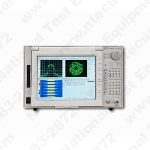Description
Features And Benefits
Seamless Acquisition for Capture of Short Duration or Intermittent Events
Analyzes in Frequency, Time and Modulation Domain
DC to 3 GHz Coverage
Frequency Event Trigger for Acquisition of Burst or Infrequently Occurring Signals
Post Capture 1000:1 Zoom Allows Analysis of Individual Signals After Wideband Capture
Code Domain Power and Complementary Cumulative Distribution Function (CCDF) for IS-95, W-CDMA Signals
CCDF for Multi-carrier and W-CDMA Signals
Applications
1st, 2nd, and 3rd Generation Cellular/PCS R&D - Including GSM, CDMA, IS-136, PDC, W-CDMA
Signature Analysis
Spectrum Monitoring
Settling Time Measurements for Oscillators and Synthesizers
Phase Hit Capture and Measurement
Debugging of Hardware/Software Interface Problems
The 3066 is a DC to 3 GHz real-time spectrum analyzer that allows the seamless capture of frequency spectra with spans up to 30 MHz (5 MHz - 3066). This allows the spectrum of burst signals, such as those from GSM, IS-136, PDC or partial rate CDMA mobile stations, to be easily captured and examined. Real-time spectrum analyzers take a very different approach compared to traditional sweeping spectrum analyzers. Rather than acquiring one frequency step at a time, the real-time instrument captures a block of frequencies all at once. Because the instrument samples these full frames constantly (rather than waiting for each discrete frequency step to be measured), the signal can come or go as it pleases and the real-time spectrum analyzer will detect the change instantly.
The 12.1 in. color TFT display allows easy viewing of spectrum, waterfall displays, spectrograms and digital modulation analysis screens. Constellation and vector diagrams can be displayed, as well as frequency, phase, magnitude, I and Q versus time, for in-depth analysis of digitally modulated signals. Users can move a marker through the time record and analyze the modulation at any point. In particular, signals with symbol rates up to 20.48 Msymbols/sec (3066 - 5.3 Msymbols/sec) may be analyzed during and after capture. This facilitates analysis of W-CDMA signals with chip rates up to 16.384 Mcps.
In addition, a frequency mask trigger allows capture of randomly occurring or infrequent signals such as intermittent spurious emissions. If the user is not interested in the period between transmission bursts, the frequency mask trigger allows capture of the "burst-on" periods, thus maximizing the number of bursts that can be captured in memory for subsequent spectral, time or modulation analysis. The user can graphically define the frequency trigger mask; this allows the trigger condition to be generated by a particular event in the frequency domain irrespective of other activity within the displayed span. This is a major benefit when the trigger condition is used to capture signals arising from intermittent spurious or spectral re-growth events.
Option 1S, automatic waveform recording, can be used to store multiple memory blocks to the internal hard drive without operator intervention. This enables unattended monitoring and recording of transient events for later review.
A 1000:1 zoom capability permits analysis to be performed on an individual signal in a multi-signal environment.
Option 20 records the statistical nature of a signal, and plots the probability of exceeding a measured average value for the waveform. A large amount of data is collected in the memory of the 3086, and Complementary Cumulative Distribution Function (CCDF) can be shown over selected periods of time to determine the effect of code selection or multi-carrier additions on the peak-to-average ratio of the waveform. Base station amplifier designers use this information to judge the distortion performance of their products. The rapid changes that occur in base station power outputs require a real-time bandwidth higher than the occupied bandwidth of the signals measured. The 3086 provides unique capability due to its 30 MHz real-time bandwidth, allowing CCDF measurements on up to 6 W-CDMA carriers simultaneously. In the 3066, CCDF measurements over a 5 MHz real-time bandwidth is possible.
Option 20: CCDF Feature Summary
Option 20 records the statistical nature of a signal, and plots the probability of exceeding a measured average value for the waveform. A large amount of data is collected in the memory of the 3086, and Complementary Cumulative Distribution Function (CCDF) can be shown over selected periods of time to determine the effect of code selection or multi-carrier additions on the peak-to-average ratio of the waveform. Base station amplifier designers use this information to judge the distortion performance of their products. The rapid changes that occur in base station power outputs require a real-time bandwidth higher than the occupied bandwidth of the signals measured. The 3086 provides unique capability due to its 30 MHz real-time bandwidth, allowing CCDF measurements on up to 6 W-CDMA carriers simultaneously. In the 3066, CCDF measurements over a 5 MHz real-time bandwidth is possible.
Option 15: IS-95 Code Domain Power
Option 15 Feature Summary:
Option 15 offers the measurement functions listed below:
Code-domain power
Measures the relative code power to total power for each channel
Code-domain power vs. Time (codegram)
The analyzer measures the code-domain power continuously for 6144 symbols (0.32 s) maximum and displays spectrogram for each symbol
Modulation accuracy and vector display
Measures EVM (error vector magnitude), amplitude error, phase error, waveform quality, and origin offset for all signals
